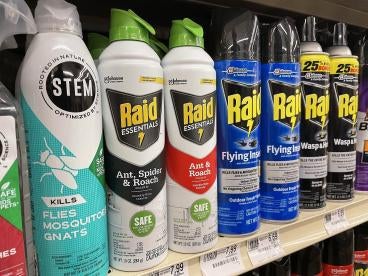On June 8, 2023, the California Department of Pesticide Regulation (DPR) issued Notice 2023-07: Pesticide Registration Program Annual Processing Timelines. Under Notice 2023-07, DPR sets forth its annual report summarizing the past five years of registration and post-registration activities. This includes the number of pesticide product registration and amendment submissions received and processed, and the average number of days to complete different types of registration submissions are also provided.
DPR states that new to the 2023 report is “information on the time spent in each of the scientific evaluation programs for currently registered active ingredients.” DPR also states that program-specific information for new active ingredient products is not available because that information is not collected in the same way in its legacy database. Prospectively, DPR states that it is developing a new electronic tracking database for pesticide registrations and, once implemented, “will allow for more refined tracking and assessment of registration timelines, including new active ingredients.”
With regard to the increases in the average processing time for registration submissions overall and in certain evaluation stations, DPR states there are two primary factors: staffing and consultation.
-
Staffing: DPR states it is currently understaffed relative to the registration workload and has found that more applications for registration are received each year than can be processed. DPR notes this is creating backlogs in the number of registration items pending in all areas of the program. To address the backlog, staff are reallocated between different evaluation stations, but it creates delays in other stations. In addition, a budget change proposal for DPR was released as a part of the May 2023 budget that includes six positions to address critical needs related to registration.
-
Consultation: DPR states that possible unnecessary routing of product amendments being routed to evaluation stations for formal scientific evaluation may be leading to increased timelines for these products. To address this concern, it has implemented a pre-routing consultation process that allows for an initial review to determine if formal scientific evaluation is needed. The pre-consultation process has added to overall staff workload and contributed to increasing timelines, but DPR believes this will ultimately reduce the workload of evaluation station formal scientific review and should improve timelines overall.
DPR notes that additional aspects of the registration program have been subject to an increased workload that reflects changes made in response to ongoing departmental evaluations focusing on ensuring compliance with various California Environmental Quality Act (CEQA) requirements. These changes include:
-
Additional public reporting;
-
Enhanced data reviews by DPR evaluation program stations (e.g., DPR’s Microbiology, Surface Water, and Ecotoxicology Programs); and
-
Peer review to ensure consistency.
Annual Submissions Received Summary
Tables 1-4 summarize the total number of submissions received during the past five years, with Table 1 providing a general overview and Tables 2-4 providing data on more detailed subcategories. New product registration submissions include new products containing new active ingredients, products containing currently registered active ingredients, subregistrations, and California-only products. Product amendments include amendments to Section 3 products (i.e., products that require federal and California registration under FIFRA Section 3) and California-only products (i.e., products that do not require federal registration but do require registration in CA, such as adjuvants). Other submissions include minimum risk pesticides, Emergency Exemptions (Section 18), Special Local Needs (Section 24(c)) registrations, and Experimental Use Permits (EUP). Additional data include but are not limited to submissions to address conditional registrations, adverse effects, risk assessment, and reevaluation.
Table 2 summarizes the total number of new product registration submissions received during the past five years by type. Currently registered active ingredient submissions include all Section 3 and subregistration submissions. Table 3 summarizes the total number of submissions received to amend currently registered products, while Table 4 summarizes the total number of original and amended other submissions received, including minimum risk pesticides, Emergency Exemptions (Section 18), Special Local Needs (Section 24(c)) registrations, and EUPs.
Table 1. Total Number of Submissions Received
|
Submission Type |
2018 |
2019 |
2020* |
2021 |
2022 |
|---|---|---|---|---|---|
|
New Products |
1,296 |
1,312 |
1,582 |
1,399 |
1,158 |
|
Amendments |
2,552 |
2,114 |
2,366 |
2,254 |
1,715 |
|
Other |
36 |
70 |
57 |
40 |
32 |
|
Additional Data |
831 |
836 |
723 |
777 |
745 |
|
Total Received per Year |
4,715 |
4,332 |
4,728 |
4,470 |
3,650 |
*Increased number of submissions in 2020 related to antimicrobial products in response to the COVID-19 pandemic.
Table 2. New Product Submissions Received
|
Submission Type |
2018 |
2019 |
2020 |
2021 |
2022 |
|---|---|---|---|---|---|
|
Currently Registered Active Ingredients |
1,167 |
1,173 |
1,484 |
1,261 |
1,066 |
|
California-Only Products |
85 |
106 |
73 |
103 |
67 |
|
New Active Ingredients |
44 |
33 |
25 |
35 |
25 |
|
Total Received per Year |
1,296 |
1,312 |
1,582 |
1,399 |
1,158 |
Table 3. Product Amendment Submissions Received
|
Amendment Type |
2018 |
2019 |
2020 |
2021 |
2022 |
|---|---|---|---|---|---|
|
Section 3 Products |
2,338 |
2,030 |
2,256 |
2,184 |
1,675 |
|
California-Only Products |
214 |
84 |
110 |
70 |
40 |
|
Total Received per Year |
2,552 |
2,114 |
2,366 |
2,254 |
1,715 |
Table 4. Other Submissions Received
|
Submission Type |
2018 |
2019 |
2020 |
2021 |
2022 |
|---|---|---|---|---|---|
|
Minimum Risk Pesticides |
10 |
6 |
1 |
2 |
6 |
|
Emergency Exemptions (Section 18) |
12 |
13 |
11 |
5 |
2 |
|
Special Local Needs (Section 24 (c)) |
14 |
50 |
44 |
33 |
24 |
|
EUPs |
0 |
1 |
1 |
0 |
0 |
|
Total Received per Year |
36 |
70 |
57 |
40 |
32 |
Summary of Registration Submissions Processed by Year
Table 5 summarizes the number of registration actions completed by year during the past five years. This summary does not include additional data submissions unrelated to a registration action processed in any given year, including but not limited to submissions associated with post-registration activities, such as conditionals, adverse effects, risk assessments, and reevaluations.
Table 5. Product Submissions Processed Summary
|
Submission Type |
2018 |
2019 |
2020 |
2021 |
2022 |
|---|---|---|---|---|---|
|
Currently Registered Active Ingredient |
1,198 |
1,087 |
1,276 |
1,370 |
1,051 |
|
California-Only Product |
102 |
78 |
96 |
78 |
84 |
|
New Active Ingredient |
25 |
28 |
40 |
38 |
30 |
|
New Products Subtotal |
1,325 |
1,193 |
1,412 |
1,486 |
1,165 |
|
Section 3 Amendment |
2,270 |
2,096 |
2,044 |
2,057 |
1,794 |
|
California-Only Amendment |
178 |
117 |
88 |
88 |
44 |
|
Amendments Subtotal |
2,448 |
2,213 |
2,132 |
2,145 |
1,838 |
|
Total |
3,773 |
3,406 |
3,544 |
3,631 |
3,003 |
Annual Timelines to Complete Different Types of Registration Submissions
Table 6 summarizes the annual average number of days to complete different types of registration submissions in the past five years. This table also includes timeline ranges for the middle 50% of submissions to complete final registration actions for the 2022 calendar year. The types of registration submissions are consistent with the registration types reported in Table 5. Currently registered active ingredient submission types include Section 3 and Section 3 subregistration submissions. This summary does not include additional data submissions processed in any given year, including but not limited to actions associated with post-registration activities, such as conditionals, adverse effects, and reevaluations.
Table 6. Summary of Annual Average Timeline (Days) to Complete Registration by Submission Type
|
Submission Type |
2018 |
2019 |
2020 |
2021 |
2022 |
2022 Range* (days) |
|---|---|---|---|---|---|---|
|
New Product with Currently Registered Active Ingredient |
122 |
138 |
156 |
195 |
191 |
113-208 |
|
California-Only Products |
111 |
173 |
140 |
179 |
194 |
145-225 |
|
New Active Ingredients |
734 |
701 |
1,242 |
1,125 |
1,191 |
393-1,832 |
|
Section 3 Amendments |
82 |
100 |
111 |
144 |
139 |
78-171 |
|
California-Only Amendments |
85 |
116 |
129 |
159 |
130 |
64-163 |
*Range represents the number of days for an action for middle 50% submissions completed in 2022.
Annual Timelines for Pesticide Programs Division (PPD) Evaluation Program
DPR summarizes the annual average number of days for a submission to complete the scientific evaluation process within each PPD evaluation program for the past five years, in Tables 7-13, which can be viewed in Notice 2023-07. Specifically, there are tables for the following programs:
-
Chemistry;
-
Pest and Disease Protection;
-
Plant Physiology;
-
Microbiology;
-
Ecotoxicology;
-
Human Health Assessment; and
-
Environmental Monitoring.
Discussion
DPR’s reports set forth numbers reflecting the average completion time for submissions over the past five years and its explanation for why average processing times are increasing. This information is important, as DPR states it can use these timeframes to estimate the potential timeframes for future submissions. DPR also caveats that “actual completion time for an individual submission could vary depending upon its complexity, review status by U.S. EPA, staff levels at any given evaluation program, and teleworking.” In addition, DPR notes that “incomplete or inaccurate submission materials or data may cause significant delays in the review process.”




 i
i


